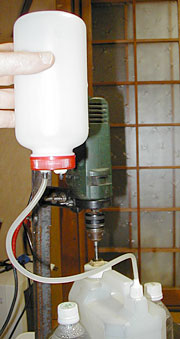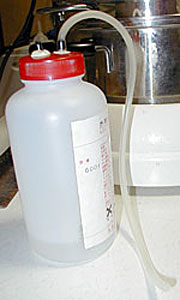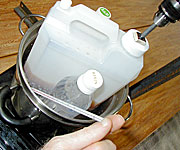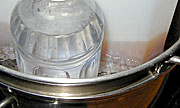
|
| Title: Vegetable Oil | |
| Dodge50 > Technical section > Bio Fuels | Go to subcategory: |
| Author | Content |
|
Brewno
|
||||||||||||||||||||||||||||||||||||||||
|
Date Posted:07/07/2004 07:42:29Copy HTML I'm still thinking about using Veg Oil to power my Dodge. My car is on its last legs and I may be forced to commute25 miles a day in my camper.I have been told that Bosch fuel pumps can handle the Veg alternative but Lucas pumps can struggle. Which pump does my mark 2 S56 use ?
|
||||||||||||||||||||||||||||||||||||||||
|
Ex_Member
|
Share to:





 #33
#33
|
|||||||||||||||||||||||||||||||||||||||
|
Re:Vegetable Oil Date Posted:22/02/2005 04:34:36Copy HTML by the style of this I'm guessing you got it from the Jouney . . . I recommend folks not to bother with that site, for the reason's you've outlined Chuggy, and a few of my own. it's foolproof method has come in for lots of criticism because even well practiced biodieselers have had trouble making good fuel with it, . . . If you've got a double first in bio-chemistry and engineering I reckon that on a good day, you could sort out the good from the bad and the down right ugly on that site. Other than that, it does your head in, a lot of the stuff contradicts itself in my book. they also deliberately hype up the deadly poison bit That's probably the bit I like best - - x - - some folks get lung cancer at 30 from the exhaust smoke from their 90 year old, '90 a day since I was 6' grandads - - x - - The trouble with safety warnings is that you hype them up. That said, illegal still have killed a few operators when they've turned out methanol instead of drinking alcohol - - x - - Like normal alcohol, methanol fumes give a warm comfortable feeling of safety. To get the chemical reaction that turns veg oil into biodiesel you need heat, I think the minimum is about 20-25 degrees C but at this temp it would need agitating for hours, so most people go for around 55 deg C
I tried going at 63 deg C once but could see slight methanol vapours starting to form on the surface when I poured the methoxide in, so I kept a safe distance just outside the garage in the fresh air, so I'm sticking with 60 deg C from now on. The 'dip your toe in the water' i've been sticking on the site has a condensation trap - - x - - What do you reckon to that idea? |
||||||||||||||||||||||||||||||||||||||||
|
Dodgy
|
Share to:





 #34
#34
|
|||||||||||||||||||||||||||||||||||||||
|
Re:Vegetable Oil Date Posted:23/02/2005 06:49:18Copy HTML Jammie you asked
I don't think you get that much difference in quality with heat variation, the reaction just goes quicker with more heat, the most critical elements for the amount of conversion(transesterification of veg oil into biodiesel methyl esters)) and the quality of the fuel are the result of the amount of methanol and catalyst used. A trap for the methanol is a good idea, but obviously involves more work to build, if you are careful and methodical you should be alright without one. Tilly's Dr pepper method is a good intro into basic biodiesel making this webpage has useful pictures Tilly's Dr pepper method from http://www.kitchen-biodiesel.com/ Dodgy Chug
|
||||||||||||||||||||||||||||||||||||||||
|
Ex_Member
|
Share to:





 #35
#35
|
|||||||||||||||||||||||||||||||||||||||
|
Re:Vegetable Oil Date Posted:25/02/2005 03:59:28Copy HTML Thank you very much for Dr Pepper Chuggy, I enjoyed it. The bit that puzzles me is that very few of the sites mention checking to see how much hydroxide is left in the oil. The next bit of the one I've been putting on the site has a con trap. - - x - - for my money, if the vapour condenses properly, the con trap can vent into the air. - - x - - although the site one doesn't. One lot boil the spare methanol off at the end of the process and condense it so that they have some clean methanol for next time. J
|
||||||||||||||||||||||||||||||||||||||||
|
Dodgy
|
Share to:





 #36
#36
|
|||||||||||||||||||||||||||||||||||||||
|
Re:Vegetable Oil Date Posted:27/02/2005 07:50:01Copy HTML Jammie I'm not sure what you mean by checking to see how much hydroxide is left in the oil, sodium or potassium hydroxide is mixed into methanol then added to the warmed oil, do you mean how much catalyst remains in the finished biodiesel? if so this depends on how much was used but should only be negligable amounts You need to have quite a bit of the glycerine by product to start reclaiming the methanol from it, people usually manage to reclaim 10 -15%, and as the methanol is the costly bit this can help reduce your costs. I really must go and get on with the work I should be doing instead of playing on here! Dodgy Chug
|
||||||||||||||||||||||||||||||||||||||||
|
Ex_Member
|
Share to:





 #37
#37
|
|||||||||||||||||||||||||||||||||||||||
|
Re:Vegetable Oil Date Posted:28/02/2005 02:28:26Copy HTML I tried that work malarky Chuggy, but never took to it. do you mean how much catalyst remains in the finished biodiesel - x - I'm not sure which bit is what they call a catalyst. I mean how much sodium hydroxide (or potassiom hydroxide) that you pour into the cooking oil is left - x - The technical sites test to see how much is left over and neutralize it - x - the backyard ones seem to keep quiet about it. The weregonnamaketheworldlastforever site mentions using a solution made from a plant to so find out how much hydroxide is left, but like to much of that site, it seemed a bit too "hippy to me man". In my book, hydroxide could seriously shorten the life of an engine. |
||||||||||||||||||||||||||||||||||||||||
|
Dodgy
|
Share to:





 #38
#38
|
|||||||||||||||||||||||||||||||||||||||
|
Re:Vegetable Oil Date Posted:03/03/2005 06:25:16Copy HTML
Dodgy Chug
|
||||||||||||||||||||||||||||||||||||||||
|
Ex_Member
|
Share to:





 #39
#39
|
|||||||||||||||||||||||||||||||||||||||
|
Re:Vegetable Oil Date Posted:05/03/2005 04:09:26Copy HTML I'm not sure what you mean by checking to see how much hydroxide is left in the oil, sodium or potassium hydroxide is mixed into methanol then added to the warmed oil, do you mean how much catalyst remains in the finished biodiesel? I've not worked out what they mean by a catalyst yet Chuggy. Which bit is the bit they call a catalyst please? I mean how much hydroxide (sodium or hydroxide) is left at the end - x - What can go wrong, will go wrong. J |
||||||||||||||||||||||||||||||||||||||||
|
Ex_Member
|
Share to:





 #40
#40
|
|||||||||||||||||||||||||||||||||||||||
|
Re:Vegetable Oil Date Posted:05/03/2005 04:29:00Copy HTML
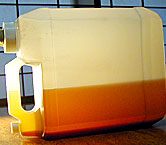 When the process is finished, disconnect the drill, remove the container and stand it on its side to settle, small lid down; later, to drain off the by-product, simply tip it up, hold it over a container and loosen the small lid, tightening again when you hit the yellow biodiesel. When the process is finished, disconnect the drill, remove the container and stand it on its side to settle, small lid down; later, to drain off the by-product, simply tip it up, hold it over a container and loosen the small lid, tightening again when you hit the yellow biodiesel. |
||||||||||||||||||||||||||||||||||||||||
|
Ex_Member
|
Share to:





 #41
#41
|
|||||||||||||||||||||||||||||||||||||||
|
Re:Vegetable Oil Date Posted:09/03/2005 03:26:57Copy HTML http://cgi.ebay.co.uk/ws/eBayISAPI.dll?ViewItem&category=36799&item=4534587977&rd=1 A very unusual item this! I am not at all sure what vehicle this was intended for but it is similar in design and construction to the "enots" type as fitted to Landrover , scammell, Ferret etc.The difference is that there is a pair of change over valves in parallel. In effect it will change over 'two tanks' to 'two tanks'. The sealing washers etc are all the same which is why I bought it. Otherwise it is just nice to have it-- so well made and a quality item Just the job for a seperate tank for chippie oil if you wish to go that route? If you wish to know how to knock an oil heater up for a fre quid, let me know on this column. J |
||||||||||||||||||||||||||||||||||||||||
|
Sir_Henry
|
Share to:





 #42
#42
|
|||||||||||||||||||||||||||||||||||||||
|
Re:Vegetable Oil Date Posted:08/02/2014 05:34:52Copy HTML I've run several cars on SVO and filtered WVO over the past few years with few problems. The proviso that Bosch fuel pumps are best for this is correct, although the occasional Philips pump may work quite well on it. It's because of the lack of decent quality control at the Philips factory. As above it's mostly down to making sure that the oil is thinned down to avoid excessive pressures in the wholly mechanical pumps. I've found that the addition of 5% unleaded (shake vigorously) to the oil a week or two before adding it to the fuel tank is the best/cheapest way to go, but 10% put straight into the tank followed by the oil so that they mix thoroughly will usually do the trick just as well.
Another tip is to start off slow. Go no higher than 50/50 for the first tankful or three before slowly ramping up the %age. Even so it's strongly advisable to add a good quality inline filter and always keep a spare standard fuel filter or two in the cab for emergency use. Get your inline filters from eBay as they can be cheaper by the dozen - equivalent to 3 or 4 for the price of one at your local car spares outlet and even dearer at Halfrauds. I've found that the best are the clear one with a red exoskeleton so that you can see the nylon filter material inside as any that use a paper filter will just disintegrate and bu66er up the lift pump inside the injector pump. DO NOT forget to check how to change it as it can be somewhat awkward if you have to explain to the fuzz why you seem to be servicing the vehicle on the hard shoulder of a motorway! Here in Blighty the cheapest SVO - apart from having a cash & carry card - is at FarmFoods. Just google for "FarmFoods vouchers" and you can get 10% off the price of £25, £50 or £100 worth of purchases in a single trip. With the oil only costing £9.95 per 10 litres this takes it down to just 90p/litre with something else (to make the bill up to the full amount) at a discount or even free! Filtering WVO is 'another country' as it's far better to assemble a proper filtering setup and doing all the filtering cold as hot filtering can allow significant amounts of fat through which can (particularly in cold weather) block the fuel lines, filter or even the injector pump. As I write I've got 1.6 tonnes of WVO on my back garden waiting for me to finish erecting my new garage (damn this rain ... Grrr) so that I can rebuild my filtering setup. HINT 1: add the 5% unleaded at the second settling stage so that it has time to work its magic and the result will be as good as - if not better than - commercially produced biodiesel. HINT 2: When replacing the fuel filter pour a full bottle of injector cleaner into it and top up with SVO to give the pump and injectors a damn good clean/flushing. |
||||||||||||||||||||||||||||||||||||||||
DATINFORMATION: dodge50.co.uk takes no responsibility for any mistakes or advice given, it's up to you if you take it or not, remember, All material is copyright dodge50.co.uk 2002-2018 unless it's someone else's and it has been begged, borrowed or made up.
DISCLAIMER: Any libel or mistakes in messages that are written by members of the community, inc the admin's and owner of this site, dodge50.co.uk takes no responsibility for them, you need to contact the author and have a moan / send a writ / agree. (delete as you see fit) Blah Blah Blah Blah Blah Blah.......Etc.......Etc...........




